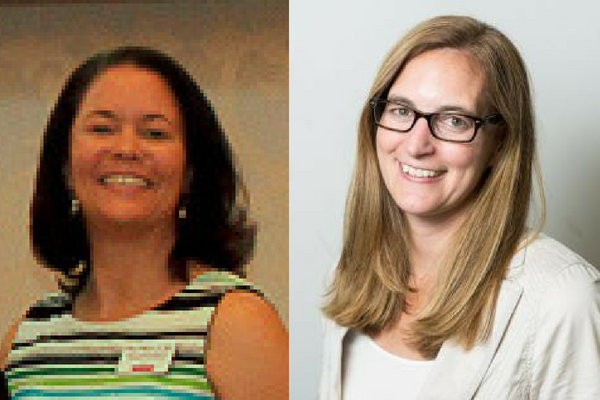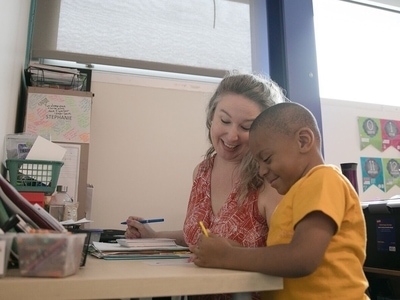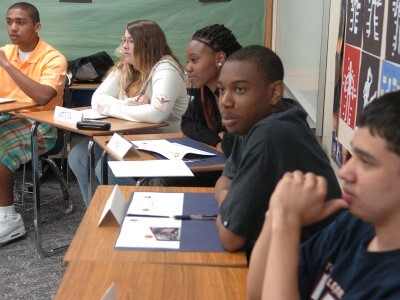Next Gen Learning: An Experiment on Other People’s Children?
Topics

Together, educators are doing the reimagining and reinvention work necessary to make true educational equity possible. Student-centered learning advances equity when it values social and emotional growth alongside academic achievement, takes a cultural lens on strengths and competencies, and equips students with the power and skills to address injustice in their schools and communities.
Holly Morris and Kristen Vogt share their personal take on next gen learning and equity by thinking deeply about what kind of school they want for their own children.
Editor’s Note: In an effort to explore issues of equity in education and current reform efforts to increase personalization through the use of blended and competency-based learning strategies, two staff members of Next Generation Learning Challenges asked themselves: “Is next gen learning an experiment on other people’s children?”
Here, Holly Morris and Kristen Vogt share their personal take on next gen learning and equity by thinking deeply about what kind of school they want for their own children.
Holding up a mirror to examine equity
The landscape of public education looks tumultuous right now. The old ways of teaching are not meeting the challenge of preparing millions of students for college and career. Success rates, especially in low-income communities of color, are atrocious.
Costs are escalating. Quality is uncertain. Teachers are asked to do a Herculean job, isolated from other educators except when they are evaluated.
This macro view got very micro in Seattle—Holly’s hometown—this fall. There, the district’s public school teachers went on strike over pay, accountability measures linking teaching and student performance on standardized tests, racial equity issues, and recess, among other things. Almost simultaneously, with the first day of school at hand, the Supreme Court decided that the not-even-open yet fledgling charters schools were unconstitutionally funded by public money, and subsequently told them to shut their doors.
In Holly’s words: “Conversation around the neighborhood and on Facebook got tense. At one point someone accused me of being ‘an idiot and a sellout’ because I work for a Gates-funded education accelerator and supported the local charter schools. The higher-minded critics suggested that charter schools amount to nothing more than ‘a rich white person’s experiment on helpless children of color.’ (For the record, NGLC supports both district and public charter schools, with diverse student populations; we’re for supporting innovation wherever it can happen, for whomever it can benefit.)”
In general, critics have also suggested that advocates of next gen learning have a vested interest in replacing teachers with technology, that we ignore the community and society-based interests of districts and local colleges in favor of our own financially-driven agenda, and we neglect to address the root cause of the problem: deteriorating public support for education. In conclusion, they argue, schools that adopt new, unproven, tech-driven practices are conducting an experiment on the most vulnerable populations.
So we asked ourselves: are the critics right? Is all of this an experiment on students of color and low-income students? Do these initiatives have the potential to harm?
While it is true that innovation has been associated with unethical behavior concerning people of color, this is simply not the case with respect to next gen learning and, as innovators in the public education space, we feel it’s important for us to take a strong, clear stand in favor of both equity and innovation.
The answer, as is often the case with persistent, intractable problems, is a better question: What’s the right frame of reference?
When is choice not a choice?
Whether you support charter schools or not, it’s beyond debate that children of color are statistically less likely to have access to high quality physical environments because our schools are funded by property taxes, which provide advantages to schools in affluent neighborhoods. Sadly, children of color are less likely to be taught by high-performing teachers, because most high-performing teachers choose to teach in predominantly white, affluent schools. In the cities where NGLC supports high quality next gen schools, children of color have long suffered from substandard public school options. For example, the stats have been especially bleak in Chicago and the District of Columbia—two of the six communities where we are funding regional partners to champion innovation in the public school system.
Without charter schools or scholarships to parochial or private schools or a high-quality district school option, most poor and minority children have no choice but to accept their subpar school. A poor education means a lower quality of life by almost every measure: likelihood of incarceration, use of illegal drugs, involvement in gangs or in the foster care system. In short, our failure to take radical action to save children in our lowest performing schools and school districts is unethical. We are all but guaranteeing their failure to survive and thrive in life. The one thing we know for sure is that adhering to the status quo of the last 20 years in those schools and school districts will earn us the same deplorable, indefensible results we’ve gotten for the past 20 years. Not only is that unethical; the repercussions of this unfortunate scenario will continue to be felt by our greater society.
Not surprisingly, most (if not all) of these kids do not matriculate into college let alone complete a degree. And their failure to go on to higher education only compounds their problems. Despite all the questions about the value of a college degree, studies demonstrate that college grads make more money and are healthier and happier over the course of their lives than their peers who did not attend and complete. Yet it’s educational malpractice to encourage kids to go to college and not actually provide them with foundational schooling that prepares them for it. For us, this underscores the imperative of preparing all children to make whatever choice is best for them—not simply accepting society’s dismal K-12 record and consigning them, once again, to a set of choices that no one would really call a choice.
Would we send our kids to school there?
Yes. In a heartbeat. There are “good” public schools here in both our towns, although, according to the Seattle Times, Seattle’s schools have one of the nation’s largest equity gaps. In Kristen’s urban fringe district, about ⅓ of students are students of color and the teaching staff and administration are racially diverse.
In Kristen’s words: “Even with decent test scores and blue ribbon awards, the schools aren’t going to support my 2nd grader the way I hope for. He loves to learn. He asks lots of questions; he inhales books; he takes toys apart to see how they work. As I watch him make his way through the routinized systems of school and as I watch his teachers struggle to differentiate without the aid of tech-based tools (nor a teacher’s aide, for that matter), my greatest fear is that he will lose his passion for learning. I’ll say that again. My greatest fear is that he will lose his passion for learning because of school. In my own way, I’m desperate too, even though what’s available to me is a ‘good’ school.”
Independent of parental prompting, both of our kids—at the time a 7th grade girl and a 1st grade boy—asked us, “When will teachers step out of the way so I can learn what I want to learn?”
This may be the most damning indictment of our traditionally modeled schools (both public and private)—that they are killing children’s natural passion for learning. And both of us would forego our ‘good’ public and private school options in favor of a next gen school because ‘good’ actually isn’t all that great, and we can do so much better for our children. All of them. Not just Holly’s and Kristen’s.
What's experimental
We get it: there’s comfort and a feeling of safety in the familiar, and next gen learning looks and feels so very different from our notion of learning in schools. Plus, next gen learning puts the power of today’s technology in the hands of educators as a tool for teaching and learning.
But as one of NGLC’s regional partners repeatedly reminds us, next gen learning is nothing new. It’s built on decades of research and best practices—what we already know to be good for learning. In a perfect world, public schools across all districts would be able to learn from, embrace, and incorporate the best strategies of charter schools, and lousy charter schools would quickly show their stripes and close their doors.
So in the end, no, this is not an experiment. For kids desperately starved of quality educational options, we’d say next gen schools are taking well-calculated risks to save the lives of those most vulnerable within our communities. For kids like ours who are fortunate enough to have access to acceptable options, we’d say, we can do better—and we’ll sign our kids up.




